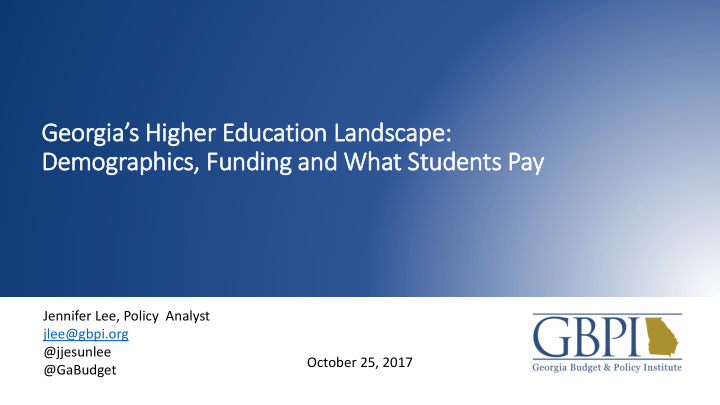



Geor Georgia’ a’s Hi s High gher er E Education L Landsc scap ape: e: Demograph phics cs, F Fund unding and and Wha hat Stude dents P Pay Jennifer Lee, Policy Analyst jlee@gbpi.org @jjesunlee October 25, 2017 @GaBudget
www.gbpi.org @GaBudget
Agenda • Why Higher Education (Still) Matters • Strengths of Georgia’s Public Higher Education System • How Higher Education Has Changed
Why Higher Education (Still) Matters • Strong Workforce • Economic Development
Why Higher Education (Still) Matters • Higher Earnings • Broad Social Benefits • Economic Mobility
SUCCESS x ACCESS = MOBILITY
Strengths of Georgia’s Higher Education System • Long tradition and support of public colleges and universities • Largest merit-based state scholarship and grant program (HOPE) • Diverse by race, ethnicity, income
How Higher Education Has Changed • More diverse • More necessary • More expensive
More e St Studen ents W ts With F h Financial N Need eed University System Enrollment 300,000 200,000 No Pell 100,000 Pell 43% 27% - 2006 2015
More e St Studen ents W ts With F h Financial N Need eed Technical College Enrollment 200,000 150,000 No Pell 100,000 Pell 50,000 52% 29% - 2006 2016
Growing R Raci cial a and E Ethnic Diver ersi sity University System Enrollment 300,000 All Other Hispanic/Latino Asian 150,000 Black or African-American White - 1976 2016
Growing R Raci cial a and E Ethnic Diver ersi sity Technical College Enrollment 150,000 All Other 100,000 Asian Hispanic 50,000 Black or African-American White - 2000 2016
Employer ers D s Dem emanding M More e Educati tion By 2020… 60 % of jobs will require postsecondary ed 32 % will require at least a bachelor’s.
More e Nec eces essa sary f for Financial Sec Secur urity Median Weekly Earnings by Educational Attainment $1,400 Bachelor's degree $1,200 or higher, $1,193 $1,046 $1,000 Some college or $857 associate's, $761 $800 $757 High school $638 graduates, $668 $600 Less than high school, $488 $400 $200 $- 1979 1984 1989 1994 1999 2004 2009 2014 Source: U.S. Bureau of Labor Statistics. Adjusted for inflation. People 25 years and older.
Key Fact ctor i in n Economic M Mobi bility and I Ineq nequality Bachelor’s Degree Attainment by age 24 by family income 70% Fourth 60% (Highest) Quartile, 58% 50% 40% 40% Third Quartile, 35% 30% Second 20% Quartile, 20% 15% 11% First (Lowest) 10% 6% Quartile, 12% 0% 1970 1975 1980 1985 1990 1995 2000 2005 2010 2015 Source: The Pell Institute, Indicators of Higher Education Equity in the United States, 2017 Historical Trend Report.
Higher Education is More Expensive
Funding and Enrollment are Sensitive to Economic Downturns
State Budget and Tuition and Fees are Related $6,000 $10,000 $5,000 $8,000 $4,000 $6,000 $3,000 $4,000 $2,000 $1,000 $2,000 $- $- 2007 2008 2009 2010 2011 2012 2013 2014 2015 2016 2017 State Funding Per-Student Average Tuition and Fees
HOPE Cuts Led to Higher Costs for Students
Highest Tuition Does Not Necessarily Mean Most Expensive 60% 50% Zell Miller Scholarship/Grant 40% HOPE 30% Scholarship/Grant 20% 10% 0% Research Comprehensive State State Colleges Technical Universities Universities Universities Colleges
Highest Tuition Does Not Necessarily Mean Most Expensive
Half of Students Use Loans to Finance Their Education
College Revenue Sources Have Changed In 2006: State Funding, 45% State Funding 35% Tuition and Fees 32% Tuition and Fees, 25% Federal Grants (includes Pell) 21% Federal Grants, 13% State Universities (ex. University of North Georgia) Percentage of Core Revenues by Source 2006 2015
College Revenue Sources Have Changed In 2015: State Funding, 45% Tuition and Fees 35% State Funding 32% Tuition and Fees, 25% Federal Grants (includes Pell) 21% Federal Grants, 13% State Universities (ex. University of North Georgia) Percentage of Core Revenues by Source 2006 2015
Lowest Tuition Does Not Necessarily Mean Most Affordable • Family making $60,000 • In 2014-15, average net price was $12,722 • Up 11 percent from five years prior
Lowest Tuition Does Not Necessarily Mean Most Affordable • Family making $30,000 (quarter of Georgia families) • In 2014-15, average net price was $9,326 • Up 32 percent from five years prior
How Higher Education Has Changed • More diverse • More necessary • More expensive
Recommendations Higher education matters. • Work to return higher education funding back to historical levels. • Designate a portion of the state treasury’s Revenue Shortfall Reserve as a pool to protect students against large tuition increases during budget cuts.
Recommendations College has become more necessary and more expensive for diverse students and families. • Develop a state aid program that responds to family financial need.
For more information & to stay involved, sign up for GBPI’s email list www.gbpi.or org Jennifer Lee, Policy Analyst jlee@gbpi.org @jjesunlee @gabudget
Recommend
More recommend